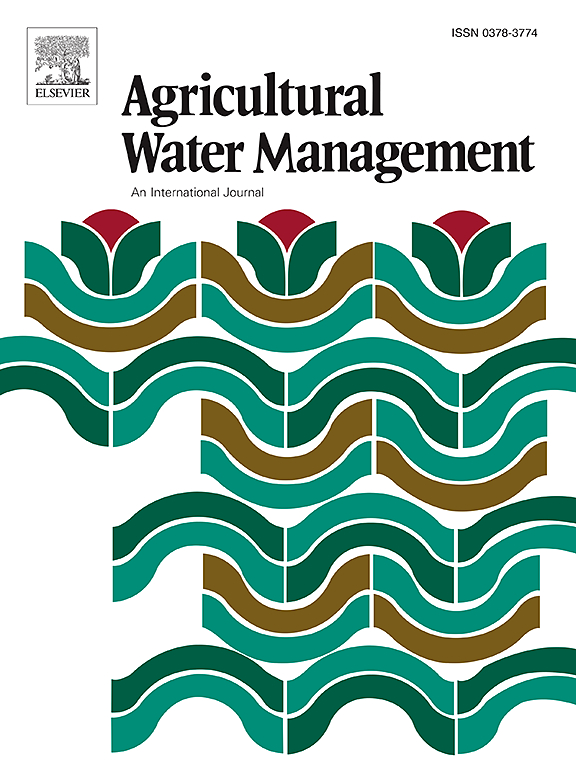Assessment of irrigation water use for dry beans in center pivots using ERA5 Land climate variables and Sentinel 2 NDVI time series in the Brazilian Cerrado
IF 6.5
1区 农林科学
Q1 AGRONOMY
引用次数: 0
Abstract
The Brazilian Cerrado is a vital agricultural region, yet its expansion often overlooks the high climate risks posed by the prolonged dry season, particularly from June to September when water demand surges, causing low-flow conditions. Recent studies highlight significant water deficits between May and October, making irrigation water use (IWU) crucial for policymakers and managers. This study estimates IWU for dry beans grown under center pivots during the dry season in the state of Mato Grosso, Brazil, a leading agricultural producer with 309,372 km² of agricultural land. Mato Grosso relies heavily on irrigation from April to October for bean cultivation. We used NDVI time series from Sentinel-2A data from 2019 to 2023 to classify dry beans areas based on t-SNE and k-means cluster classification. The individual NDVI time series for the dry season for each pivot was divided based on the peak NDVI values to analyze phenological parameters- such as duration, start and end of the season- to assess water needs from April to September. ERA-5 Land climate data provided daily reference evapotranspiration (ETo) and precipitation (P), which were used to compute the crop’s water requirement. Irrigation depth (D) was estimated using a water balance equation incorporating crop coefficients (Kc) and daily irrigation needs adjusted for efficiency. The analysis shows that dry-season irrigation in the Cerrado primarily replenishes soil moisture, often leading to inefficient water use. From 2019–2023, IWU increased significantly, with the model showing a strong correlation (R² = 0.92) to reported accumulated irrigation depth for center pivot during the dry season. However, the model underestimated needs from May to July and overestimated in August, with a bias of −21.88 mm. The North subregion, benefiting from favorable conditions, accounted for 43 % of the state's IWU. The study provides valuable insights into IWU trends, supporting strategic decisions and resource allocation, while offering a cost-effective method for real-time IWU estimation.
利用巴西塞拉多地区ERA5陆地气候变量和哨兵2号NDVI时间序列评估中心枢轴旱豆的灌溉用水量
巴西塞拉多地区是一个重要的农业区,但其扩张往往忽视了长期旱季带来的高气候风险,特别是在 6 月至 9 月期间,用水需求激增,造成低流量状况。最近的研究强调了 5 月至 10 月间的严重缺水问题,这使得灌溉用水量(IWU)对政策制定者和管理者至关重要。本研究估算了巴西马托格罗索州旱季中心枢轴种植干豆的灌溉用水量。马托格罗索州的豆类种植在很大程度上依赖于 4 月至 10 月的灌溉。我们利用 Sentinel-2A 数据中 2019 年至 2023 年的 NDVI 时间序列,基于 t-SNE 和 k-means 聚类分类法对干豆区域进行了分类。根据 NDVI 峰值划分每个枢轴旱季的单个 NDVI 时间序列,分析物候参数,如季节的持续时间、开始和结束时间,以评估 4 月至 9 月的需水量。ERA-5陆地气候数据提供了每日参考蒸散量(ETo)和降水量(P),用于计算作物的需水量。灌溉深度(D)是通过水量平衡方程估算得出的,其中包含作物系数(Kc)和根据效率调整后的日灌溉需求。分析表明,塞拉多地区旱季灌溉主要是补充土壤水分,往往导致用水效率低下。从 2019-2023 年,IWU 显著增加,模型与报告的旱季中心枢轴累计灌溉深度有很强的相关性(R² = 0.92)。然而,该模型低估了 5 月至 7 月的需求,高估了 8 月的需求,偏差为-21.88 毫米。北部次区域受益于有利条件,占该州 IWU 的 43%。这项研究为了解 IWU 趋势提供了有价值的见解,为战略决策和资源分配提供了支持,同时也为实时估算 IWU 提供了一种具有成本效益的方法。
本文章由计算机程序翻译,如有差异,请以英文原文为准。
求助全文
约1分钟内获得全文
求助全文
来源期刊

Agricultural Water Management
农林科学-农艺学
CiteScore
12.10
自引率
14.90%
发文量
648
审稿时长
4.9 months
期刊介绍:
Agricultural Water Management publishes papers of international significance relating to the science, economics, and policy of agricultural water management. In all cases, manuscripts must address implications and provide insight regarding agricultural water management.
 求助内容:
求助内容: 应助结果提醒方式:
应助结果提醒方式:


